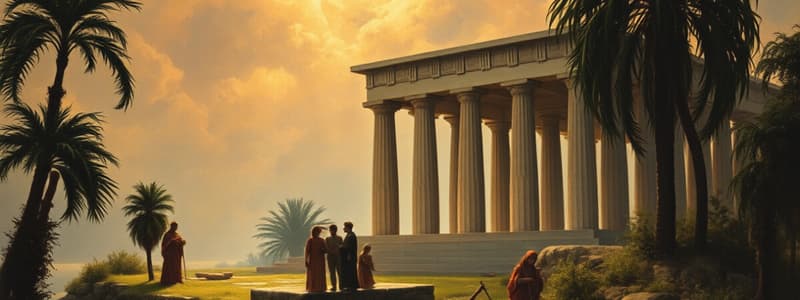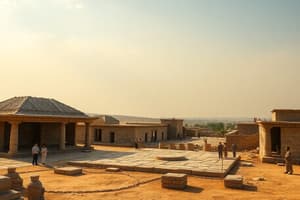Podcast
Questions and Answers
What is civilization?
What is civilization?
- A form of writing
- A tiered structure
- Exchanging goods and services
- The stage of human social development considered most advanced (correct)
What is specialization?
What is specialization?
The development of skills in a specific kind of work
What is an artisan?
What is an artisan?
A worker in a skilled trade, especially one that involves making things by hand
What is an institution?
What is an institution?
Who is a scribe?
Who is a scribe?
What is cuneiform?
What is cuneiform?
What characterizes the Bronze Age?
What characterizes the Bronze Age?
What is barter?
What is barter?
What is a ziggurat?
What is a ziggurat?
How did life become more complex?
How did life become more complex?
Name the five features of a civilization.
Name the five features of a civilization.
What social classes existed in Ur?
What social classes existed in Ur?
Flashcards
Civilization
Civilization
The most advanced stage of human social development.
Specialization
Specialization
The development of skills in a specific kind of work.
Artisan
Artisan
A skilled worker who makes things by hand.
Institution
Institution
An organization formed for specific goals like religion, education, or social purposes.
Signup and view all the flashcards
Scribe
Scribe
A person who copies or writes out documents.
Signup and view all the flashcards
What is cuneiform?
What is cuneiform?
A form of writing developed by the Sumerians using a wedge-shaped stylus and clay tablets.
Signup and view all the flashcards
Bronze Age
Bronze Age
Historical period characterized by the use of bronze.
Signup and view all the flashcards
Barter
Barter
Exchanging goods and services without using money.
Signup and view all the flashcards
Ziggurat
Ziggurat
A tiered, pyramid-shaped structure that formed part of a Sumerian temple.
Signup and view all the flashcards
How did life become more complex?
How did life become more complex?
Villages grew, leading to specialization, social divisions, and belief in deities for agricultural protection.
Signup and view all the flashcards
Features of Civilization
Features of Civilization
Five features include: 1. Advanced cities, 2. Specialized workers, 3. Strict institutions, 4. Scribes for record keeping, 5. Tools for technology.
Signup and view all the flashcards
Social Classes in Ur
Social Classes in Ur
Rulers, priests, craft workers, and artists formed the main social groups.
Signup and view all the flashcardsStudy Notes
Key Concepts in Sumerian Civilization
- Civilization: Represents the most advanced stage of human social development and organization.
- Specialization: Involves the development of unique skills dedicated to specific types of work.
- Artisan: Refers to a skilled worker, particularly one who creates handcrafted items.
Institutions and Roles
- Institution: An organization with a focus on religious, educational, social, or similar purposes.
- Scribe: A professional tasked with transcribing documents; critical for record-keeping.
Writing and Technology
- Cuneiform: An innovative writing system used by the Sumerians, characterized by wedge-shaped markings on clay tablets.
- Bronze Age: A historical period noted for the widespread use of bronze as a material.
Economic Practices
- Barter System: A method of trade that involves the direct exchange of goods and services, often requiring negotiation of terms.
Architectural Significance
- Ziggurat: A distinctive multi-tiered structure that served as a key component of Sumerian temples, reflecting the civilization’s architectural ingenuity.
Complexity of Life in Sumer
- Life complexity increased with urban growth, leading to societal divisions based on wealth and resources, including a belief system focused on gods for agricultural protection.
Features of Civilization
- Advanced cities serve as trade centers.
- Specialized workers enhance economies through skill development.
- Strict institutions contribute to societal organization and economic stability.
- Scribes maintain essential records, emphasizing the importance of documentation.
- Development of tools and technology aided in problem-solving and innovation.
Social Structure in Ur
- Social classes included rulers, priests, craft workers, and artists, showcasing a stratified society with distinct roles and responsibilities.
Studying That Suits You
Use AI to generate personalized quizzes and flashcards to suit your learning preferences.




